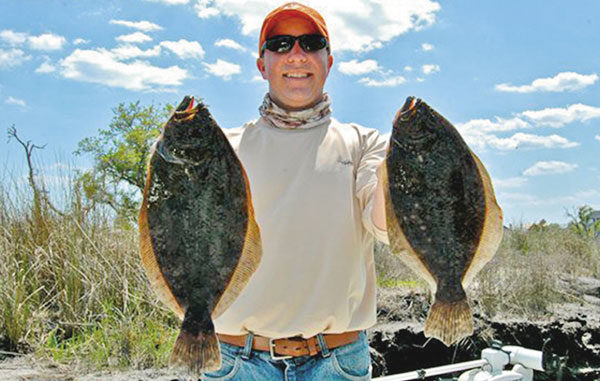
The fringes of the Roanoke, Albemarle, Pamlico and Croatan sounds are full of flatfish for the taking — if you know how.
The colonists making up the first permanent English settlement in the New World might not have perished had Sir Walter Raleigh included fishing tackle as part of their tools for survival. The failed settlement on Roanoke Island was surrounded by pristine, grass-covered marshes abundant with rich sea life. If Capt. Reese Stecher had been part of that initial colonial charter, the “Lost Colony” may have succeeded.
Stecher, who operates Beach Bum Fishing Charters, began fishing the waters along the Outer Banks 15 years ago, and he continues to practice his angling techniques in the shallow marshes of the Roanoke and Croatan Sounds landing bumper catches of speckled trout, red- fish and doormat flounder. Stecher manages to lasso his fair share of flatties in the tepid waters of summer.
North Carolina’s fringe is among the grandest coastal ecosystems in the entire United States. The two largest bodies of water, the Albemarle and Pamlico sounds, converge and form a unique estuarine environment. Conditions within these waters are ideal for harboring baitfish and hefty flounder. Freshwater flows from the north and meets the salty waters of the eastern Pamlico Sound and Oregon Inlet, through which the estuary is filled with rich, saline waters. Roanoke Island lies right smack in the middle of the bottleneck, flanked by the Roanoke and Croatan sounds. Stecher concentrates his efforts around Roanoke Island and the western banks of Bodie Island.
“The southern, western, and eastern quadrants around the island get a direct input of saltwater daily from Oregon Inlet, and they have the most flounder habitat.
“The points and small marsh islands harbor fleeing bait, and that is generally where we catch flounder during the summer, especially on falling water.”
Shallow, grass-covered marshes and mud flats offer small fish and shrimp places to forage and conceal themselves from gamefish lurking nearby. But eventually, the tides recede and wash these tender morsels into areas where predators await the current that will sweep in their next meals. Flounder are ambush feeders; they will position themselves along the outer fringes of the island when the tides recede.
“Baitfish get swept out of the shallow bays and creeks. They seek the nearest protective cover available, which ends up being small grassy clumps or flooded grass points,” Stecher said.
The points along the marsh edges of the eastern Albemarle Sound are deadly for locating doormat flounder. Every creek mouth has two points, one on either side. Current and tide form pockets along those banks. Stecher looks for areas around the creek mouths with deeper cuts to find hiding flounder.
“Flounder stack up along the banks of these erosion cuts at the mouth of small creeks,” he said.
The waters making up the Croatan and Roanoke sounds have little topographic rise to the adjacent mainland, and light can penetrate to the bottom. In addition to marsh grasses above the waterline, these sounds have a significant level of submerged aquatic vegetation (SAV): eelgrass, shoal grass, and wigeon grass. These grasses lie in clumps along the bottom, offering fleeing baitfish and shrimp areas of refuge. Flounder lie along the margins of the grassbeds and ambush bait as well. Stecher seeks submerged vegetation and presents his offerings along their margins.
Despite the generally shallow nature of the bodies of water, deeper cuts and holes exist, creating ambush points and a cool refuge from the sweltering summer heat. Capt. Jeff Onley of Three Blonds Charters specifically targets flounder along these abrupt depth changes. Based out of Elizabeth City, Onley’s prime flounder areas are the eastern Albemarle Sound and Mann’s Harbor.
“I generally will locate flounder holding in areas with dramatically changing depths, specifically from four to 12 feet,” he said.
Onley drifts along these breaks, moving from the shallow to the deep and vice-versa. Flounder will move up and down the break and will hold at different positions or different depths depending on water conditions. He also prefers some level of current. The current organizes baitfish movements and orients ambushing predators into the current. Onley notes the location and depth of his strikes so he can build a daily pattern based on depth, tidal stage and wind direction.
The Albemarle and Currituck sounds, tides are all wind-driven, and current is not very discernible, but Mann’s Harbor and Croatan Sound have significant currents. I prefer an incoming tide in these areas,” Onley said.
Flounder consume gobs of small fish and shrimp on a daily basis. Finger mullet, small croaker and spot are staple foods for flounder in the eastern Albemarle, Roanoke, and Croatan sounds, which are chocked full of these juvenile fishes. When using live baits, Onley relies on small croaker and spot to entice flounder to bite.
“Croakers are key. Usually, there will be flounder around where there are bumper schools of croaker hanging around. Flounder love the taste of croaker,” said Onley, who fishes live bait using a 3-way swivel with a 12-inch dropper, 3-foot leader, and a 3/0 to 4/0 Kahle (live bait) hook. Often, he will also use a spinner and skirt in front of hook as well to seize the fish’s attention when fishing is slow.
Stecher also uses live baits when targeting flounder, but he rigs them on ¼- to 3/8-ounce jigheads or Carolina rig-style with the smallest egg sinker possible and a 3/0 to 4/0 Octopus-style circle hook.
Even with their keen double vision, flounder are easily duped by artificials that resemble a cruising minnow or fleeing shrimp. Stecher relies on Fin-S, Flukes and Gulp! shrimp, jerkshad, and swimming mullet in a variety of color patterns: chartreuse, white, and new penny. He rigs these soft baits on the same ¼- to 3/8-ounce jigheads he uses with live bait, depending on level of current and depth of water.
“I try to use the lightest jigs possible still maintaining their action and proper castablility,” Stecher said.
During slow periods, Stecher tips his hooks with small pieces of shrimp to strengthen the scent dispersion into the water often enticing strikes.
Whether using artificial or live baits, a flounder connection is eminent for the patient angler throughout the highly-productive bottleneck between the state’s two largest estuaries. In fact, commercial fishermen within these areas rely almost solely on flounder for their livelihoods. Using proper techniques, even the slickest flatfish lurking in the shadows will hit a properly presented lure or bait, rewarding the angler with bumper catches of tasty flounder for the dinner
table.

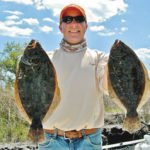
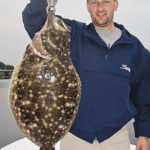
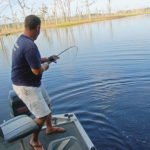
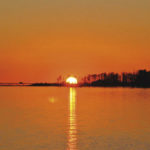
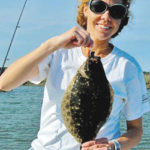
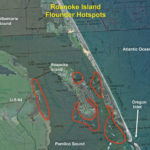



Be the first to comment